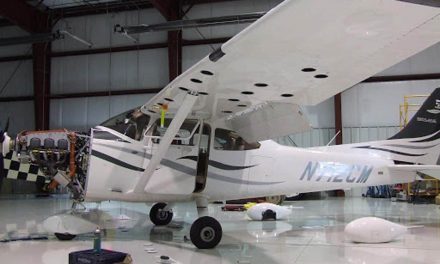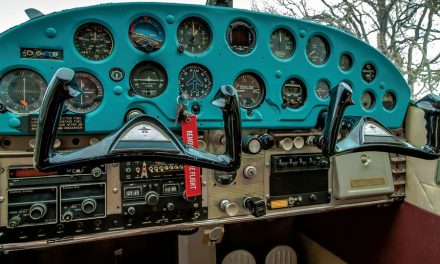During my 22 years as an avionics consultant I’ve seen the focus in avionics change. When I joined Eastern Avionics in 1997 the buzz word was GPS, which with the introduction of the first GNS-430 in 1998 became integrated navigators. We had the multi-function display phase in the early 2000s. Stand-alone MFDs from BendixKing, UPSAT, Garmin, and Avidyne are gone, discontinued, and replaced by large format navigators like Garmin’s GTN-750 and Avidyne’s IFD540/550 and EFIS. We are in the EFIS phase now!
So, what is EFIS?
An electronic flight instrument system (EFIS) displays flight data electronically rather than electromechanically.
EFIS has been around for a while — there were early EFIS options found in corporate aircraft — but the EFIS concept didn’t hit the GA market until Avidyne introduced the Entegra in 2003 as part of a factory installed panel in the Cirrus SR20 and SR22. The Entegra included big screen PFD/MFDs designed to work with external avionics — typically Garmin. Garmin introduced its G1000 EFIS option in 2004 originally in the Cessna 172/182; it later became available in several other GA aircraft as a factory installed option. The G1000 offered a complete, integrated suite with big-screen EFIS PFD/MFD including integrated comms, navs, and transponder. Neither the Avidyne Entegra nor the Garmin G1000 ever made it to the retrofit market. Instead, Garmin introduced the G500 in 2009, which was a retrofit EFIS option that was essentially the EFIS PFD/MFD portion of the G1000 that was also dependent on external avionics. The Avidyne Entegra remained an OEM-only option in Cirrus aircraft. The G500 was an expensive upgrade and required a new panel be designed and built (an additional $1,500-$2,500) to replace the aircraft’s original factory panel. It was out of the financial reach of many aircraft owners who appreciated the benefits of solid-state instruments but simply couldn’t justify the $25,000 investment. Aspen Avionics came along about the same time with a different approach to adding EFIS.
This article originally appeared in the October 2019 issue of Cessna Owner magazine.
Aspen Avionics
In 2004, several seasoned avionics and manufacturing professionals got together and formed Aspen Avionics. In 2005, Aspen introduced its first product, the AT300 Hazard Awareness Display. Designed to directly replace a mechanical VSI and provide that information digitally, it also served as a terrain awareness display. From my seat at Eastern Avionics, it was moderately successful. The introduction of the first Evolution EFD1000 PFD/horizontal situation indicator in 2008 put Aspen Avionics on the map.
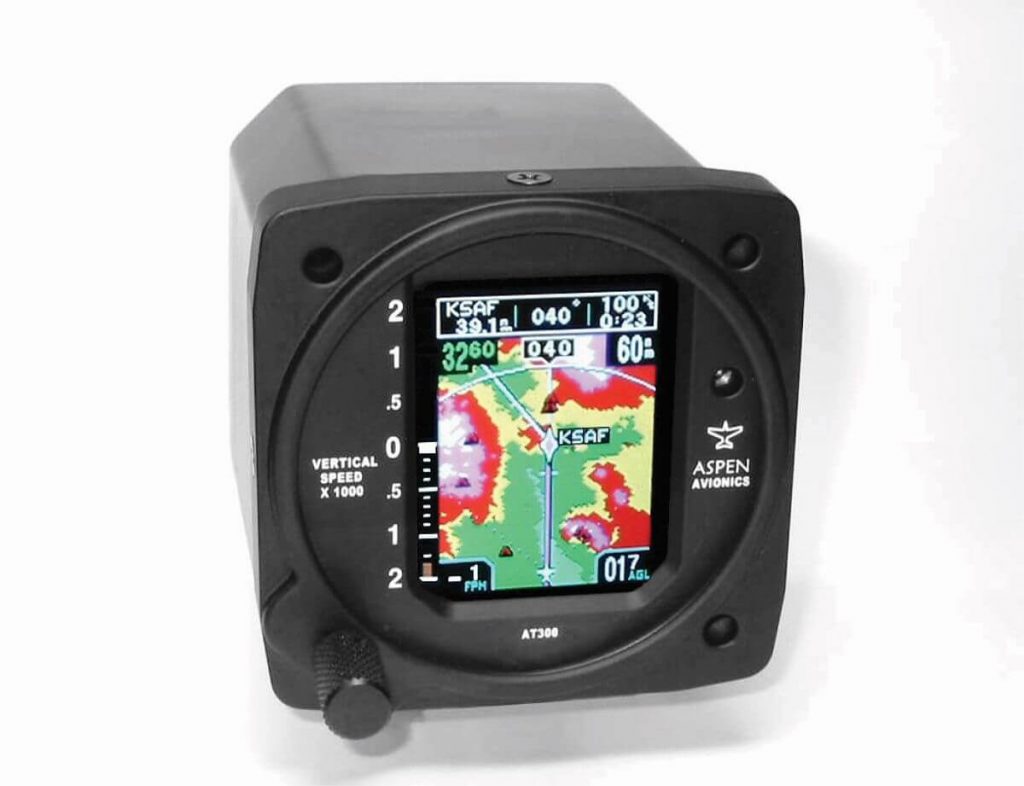
The first thing I noticed as an avionics consultant is that with the Aspen EFD1000 you could add an ADHRS-controlled, solid-state attitude indicator and HSI with battery backup to your aircraft without cutting a new panel and at the same time eliminate the aircraft’s vacuum system and less reliable vacuum-driven, mechanical directional gyro, AI, or HSI. For me, it became the only sensible way to add an HSI to an aircraft that lacked one. You could install the EFD1000 and get a solid-state HSI along with all the other benefits found in the Evolution Flight Display for a lot less than you would spend to install a slaved, mechanical HSI like the BendixKing KCS-55A, the most popular mechanical HSI at that time. The other feature that came a little later was the ability of the EFD1000 to interface and enhance most legacy autopilots with an optional EA100 adapter. Affordable autopilots like we are seeing today didn’t exist back then so keeping your functional legacy analog autopilot and improving its performance (with ADHRS digital sensing) was a big plus — it’s still a big plus! Around that time, GPSS roll steering was becoming a popular option for pilots with upgraded WAAS navigators flying a significant amount of harder IFR and the associated WAAS GPS approaches. It was a minimum $3,000 add-on for pilots flying behind older analog systems but a built-in feature in the EFD1000, further supporting its value versus the few EFIS options that were available at the time.
The Evolution PFD came in three models: The EFD1000 Pro designed for the more serious IFR pilot including optional synthetic vision (and later angle of attack), the EFD1000 Pilot created with VFR/light IFR flying in mind, and the EFD1000 VFR. The Pilot version had a DG versus HSI and no autopilot interface option. While the PFD/HSI is the heart of the Aspen Evolution series, Aspen still offers two MFD versions that can expand the capability and information at your fingertips.
The MFD1000 offered internal battery backup and provided full PFD redundancy in the event of a failure of the primary PFD. Backup instruments were required. The MFD500 without AHRS could be an affordable MFD option or serve as a third screen giving you the option of one, two, or three EFIS screens, all designed in a form factor that allows you to install them in your existing panel thus saving on installation costs! After a very successful run for the EFD1000, Aspen introduced the new generation of the Evolution series at EAA AirVenture Oshkosh 2018 and it is now STC’d and available for installation in your Cessna aircraft.
Aspen Evolution EFD1000 Pro MAX
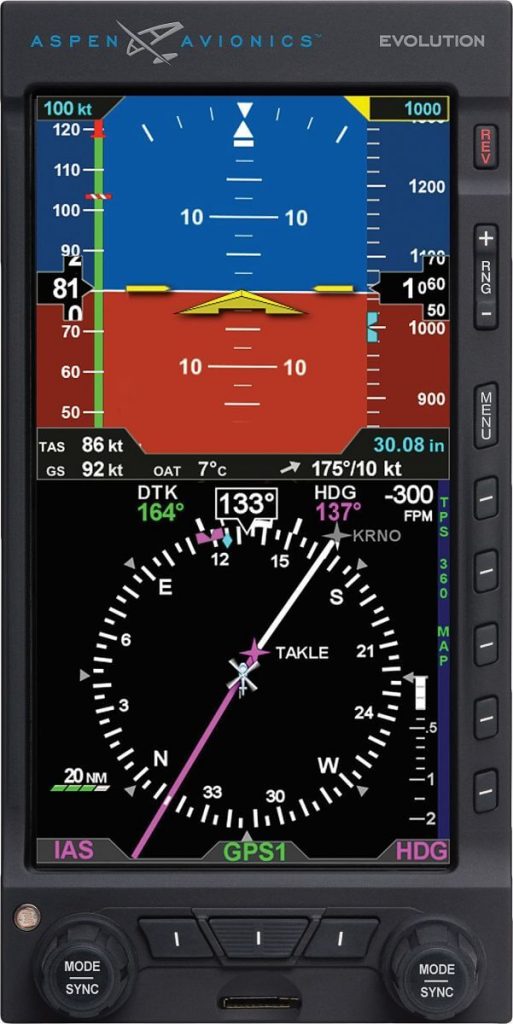
Display technology has come a long way since the introduction of the EFD1000 in 2008 so that’s the first thing you will notice when you compare the original to the EFD1000 Pro MAX, which has a list price of $9,995. The new MAX series displays represent the latest in aviation glass, bolder and brighter with customer-requested improvements including larger fonts and windows. Font sizes triple in size when items are selected, making it easy to identify your selection! New electronics provide better reliability and faster processing speeds. Zoom levels are enhanced to 350 nm. An audio panel interface allows for voice annunciation, from the MAX, when interfaced to just about any audio panel that’s still in use today. It talks to you when necessary.
In addition, the new EFD1000 Pro MAX includes:
- GPS-aided ADHRS in the event of a pitot/static failure.
- Airspeed and altitude tapes with altitude alerter (with separate approach minimums).
- Built-in GPS roll steering (GPSS).
- Full electronic HSI with dual bearing pointers.
- Base map with flight plan legs and waypoints, curved flight paths, and nearby navaids.
- Backup instruments are eliminated when you add the MFD1000 MAX.
- Altitude intercept based on climb rate.
- Synthetic vision and angle of attack standard in the EFD1000 Pro Plus MAX.
- Up to two-hour backup battery life in the event of a loss of electrical power.
Aspen MFD1000 MAX and MFD500 MAX
As I mentioned, you can expand the capabilities of the Aspen PFDs by adding one or two MFDs to your panel designed to enhance safety and increase information at your fingertips. Aspen’s form-factor allows you to use your factory panel by using the existing 3-inch instrument holes further reducing installation costs. The MFD1000 MAX also includes the same ADHRS solid-state gyro found in the EFD allowing for full “revisionary” capability in the event that the primary EFD should fail. With the push of a button, the MFD1000 MAX becomes the primary PFD and can be switched between the PFD and MFD role. Plus, the addition of the MFD1000 Max eliminates the need for backup instruments.
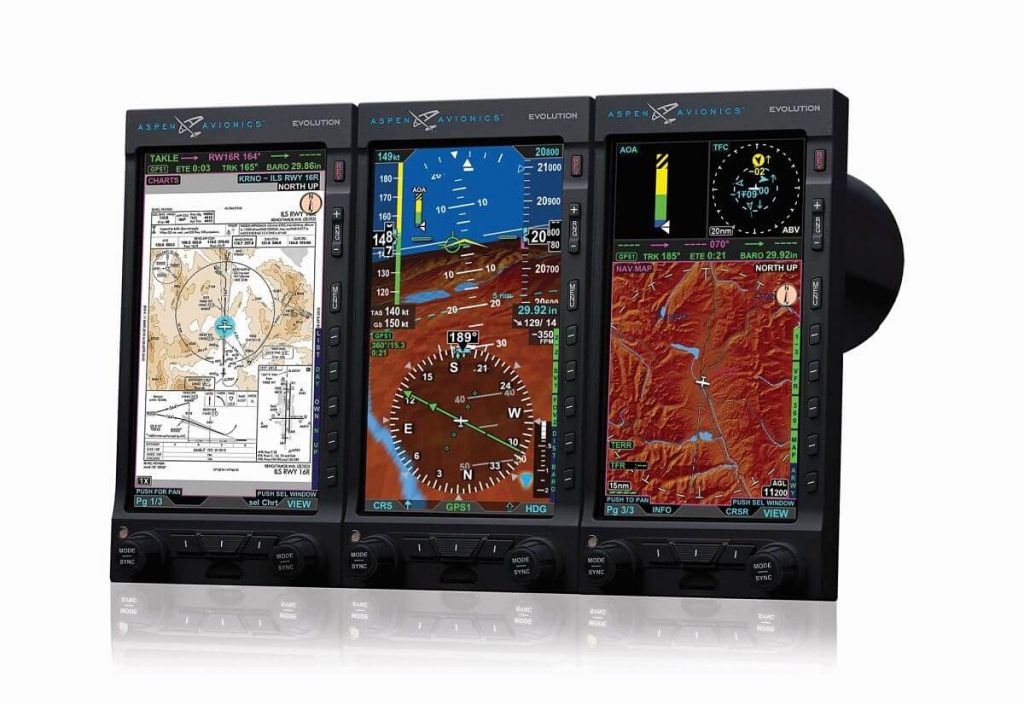
Both MFDs provide the following:
- Chart and countdown timers.
- Height AGL on navigation and terrain maps.
- METAR flags on navigation map.
- Sectional-style moving maps with hazard awareness overlays.
- Customizable screen layouts.
- Charts and geo-referenced airport diagrams.
- Built-in backup battery (up to two hours).
- Built-in terrain awareness.
- Traffic overlay on map via interface with compatible traffic systems.
MAX Display Upgrade Program
I’ve seen more than one occasion in my years as an avionics consultant where an avionics manufacturer introduced an updated product and left the owner of the previous model behind by eliminating support or by requiring a whole new installation in order to make the upgrade. Aspen takes pride in not being that type of company. Previous owners who have the original EFD1000 can upgrade to the new 1000 Pro MAX for $4,995. Owners with the Evolution 1500 or 2000 two-screen system can update to MAX (both screens) for $6,995 and owners with the Evolution 2500 three-screen system can upgrade to MAX for $7,995! Other than adding new features like an audio panel interface, the new MAX units will easily replace your existing EFDs and MFDs with the absolute minimum from your avionics shop. Aircraft owners who already own an EFD1000 Pro PFD or MFD can upgrade to the MAX and get a new two-year manufacturer’s warranty. In addition, if you have a VFR or Pilot version of the EFD, there’s an upgrade path for you to the MAX!
Aspen Evolution E5 Dual Electronic Flight Instrument
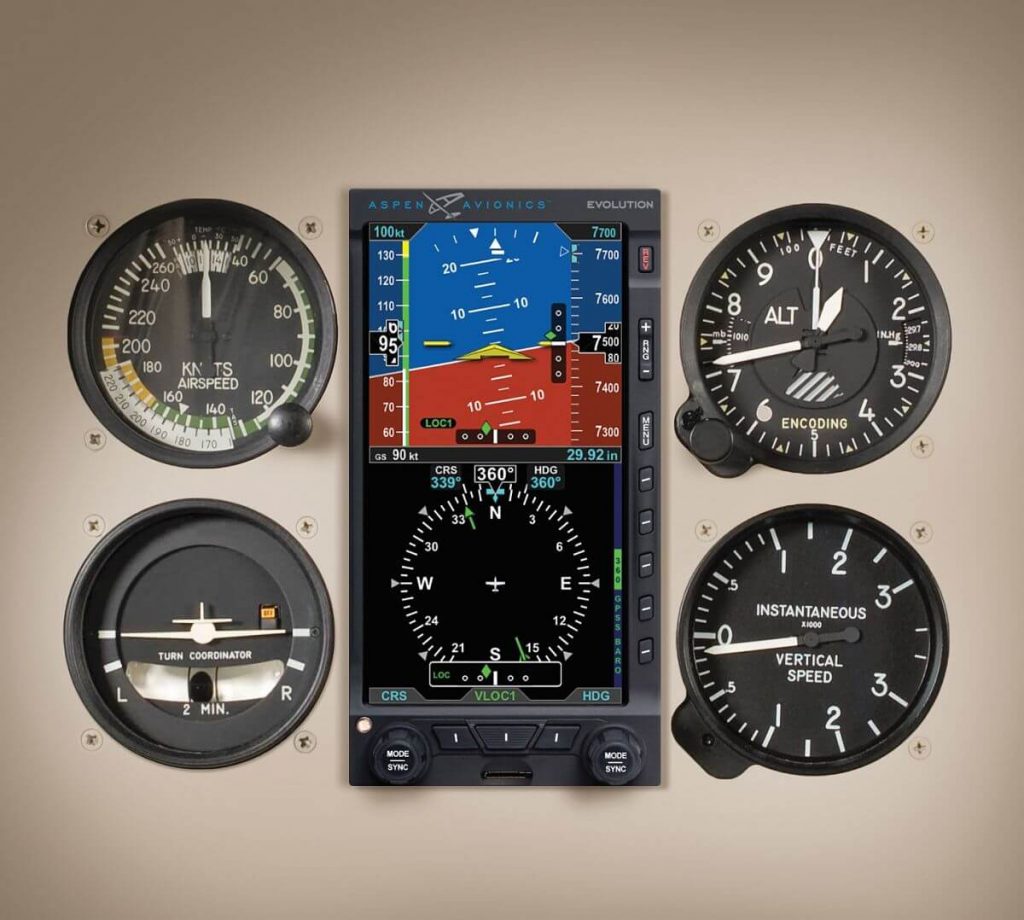
Unlike the EFD1000 Pro MAX, which can pretty much take you wherever you want to go in IFR conditions, the Evolution E5 (list price $4,995) is designed for the VFR and light IFR pilot.
For VFR pilots, the E5 can be installed without a panel-mounted GPS and can replace your existing vacuum AI and DG, allowing you to remove your vacuum pump. Add an IFR GPS and the E5 becomes an excellent tool for light IFR. Aircraft owners with “healthy” legacy autopilots that require the existing AI to serve as an autopilot position sensor can also remove their AIs by adding the optional EA100 autopilot adapter ($2,995 list). If budget allows, the EA100 adapter is well worth the investment.
Like the previous Aspen VFR and Pilot versions of the EFD, the E5 is upgradable to the EFD1000 Pro MAX or the Pro Plus MAX. So, you can add the E5 to your VFR aircraft and upgrade for IFR as your experience and ratings grow.
The Evolution E5 offers the following features:
- Backup attitude indicator not required.
- Consolidates traditional AI and DG into a single display.
- Autopilot compatibility interfaces to the new TruTrak Vizion Autopilot.
- Compatible with most legacy autopilots (with optional EA100).
- Includes GPSS and ADAHRS.
- Large, 6-inch diagonal, 400-by-760-pixel TFT Active Matrix LCD screen with bolder/brighter resolution.
- Rechargeable lithium-ion external backup battery with up to two hours of battery life.
- Works with your panel’s existing avionics.
- Unique form-fit design slides easily into existing panel cutouts.
- Provides a path for removal of vacuum instruments.
EA100 Autopilot Adapter
As I’ve said many times, any aircraft that is flown in IFR conditions, especially with a low-time IFR pilot and his family on board, should have an autopilot. Often avionics upgrade budgets require an aircraft owner to choose between upgrading to EFIS or upgrading the autopilot. With an Aspen EFD, you don’t have to make that choice. If you have a reasonably reliable legacy, analog autopilot, like the Cessna 400 series autopilot that uses the aircraft’s vacuum, mechanical AI as the autopilot’s position sensor, you can add the EA100 adapter to your EFD1000 or E5 installation, remove the old AI and now that older legacy autopilot will benefit greatly from the digital solid-state ADHRS in the EFD/E5. You’ll have a safer, more reliable autopilot that will likely fly and transition smoother. The EA100 adds about $3,500 installed to the EFD1000 or E5 installation.
I’ve written extensively about the potential pitfalls of a vacuum mechanical horizon, especially one that is the position sensor for your autopilot. The vacuum pump is also suspect in IFR in a single-engine aircraft. The EFD1000 or E5 with the EA100 adapter eliminates this issue. The EA100 improves legacy autopilots by providing them with superior digital attitude information and Aspen is the only avionics manufacturer to offer this level of autopilot integration and reliability.
Conclusion
No question, Garmin’s G5 is getting a lot of attention. The majority of G5 installations I see include an upgrade to the GFC500 autopilot that requires dual G5s. If you haven’t noticed, this installation also requires that you have modern, digital navigation equipment. Your standard nav/comms or legacy GPS are not compatible with the G5/GFC500 installation. On the other hand, the Aspen EFD1000 Pro MAX or E5 work just fine with most legacy avionics and with the addition of the EA100 will enhance your legacy autopilot while making it more reliable.
If you’re flying a legacy aircraft and tackling an avionics upgrade, a new autopilot can take a big chunk out of you upgrade budget. If you’re considering a move toward EFIS, be sure to include a serious look at the new Aspen EFD1000 Pro MAX or the E5 EFDs. The addition of EFIS to your panel will make it a safer, more comfortable flight and, with all things considered, just might save you a little money in the process.
Thanks for reading!
Until next time — safe and happy flying!
This article originally appeared in the October 2019 issue of Cessna Owner magazine.

